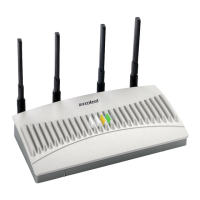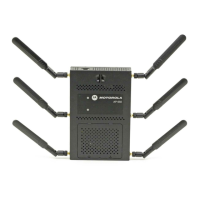Configuring Access Point Security
6-7
4. Enable and configure an Authentication option if necessary for the target security policy.
5. Enable and configure an Encryption option if necessary for the target security policy.
Manually Pre-Shared
Key / No
Authentication
Select this button to disable authentication. This is the default
value for the Authentication field.
Kerberos Select the Kerberos button to display the Kerberos
Configuration field within the New Security Policy screen. For
specific information on configuring Kerberos, see Configuring
Kerberos Authentication on page 6-8.
802.1x EAP Select the 802.1x EAP button to display the 802.1x EAP Settings
field within the New Security Policy screen. For specific
information on configuring EAP, see Configuring 802.1x EAP
Authentication on page 6-11.
No Encryption If No Encryption is selected, encryption is disabled for the
security policy. If security is not an issue, this setting avoids the
overhead an encryption protocol causes on the
access point. No
Encryption is the default value for the Encryption field.
WEP 64 (40-bit key) Select the WEP 64 (40 bit key) button to display the WEP 64
Settings field within the New Security Policy screen. For specific
information on configuring WEP 64, see Configuring WEP
Encryption on page 6-16.
WEP 128 (104-bit key) Select the WEP 128 (104 bit key) button to display the WEP 128
Settings field within the New Security Policy screen. For specific
information on configuring WEP 128, see Configuring WEP
Encryption on page 6-16.
KeyGuard Select the KeyGuard button to display the KeyGuard Settings
field within the New Security Policy screen. For specific
information on configuring KeyGuard, see Configuring KeyGuard
Encryption on page 6-18.
WPA/WPA2 TKIP Select the WPA/WPA2 TKIP button to display the WPA/TKIP
Settings field within the New Security Policy screen. For specific
information on configuring WPA/WPA2 TKIP, see Configuring
WPA/WPA2 Using TKIP on page 6-21.

